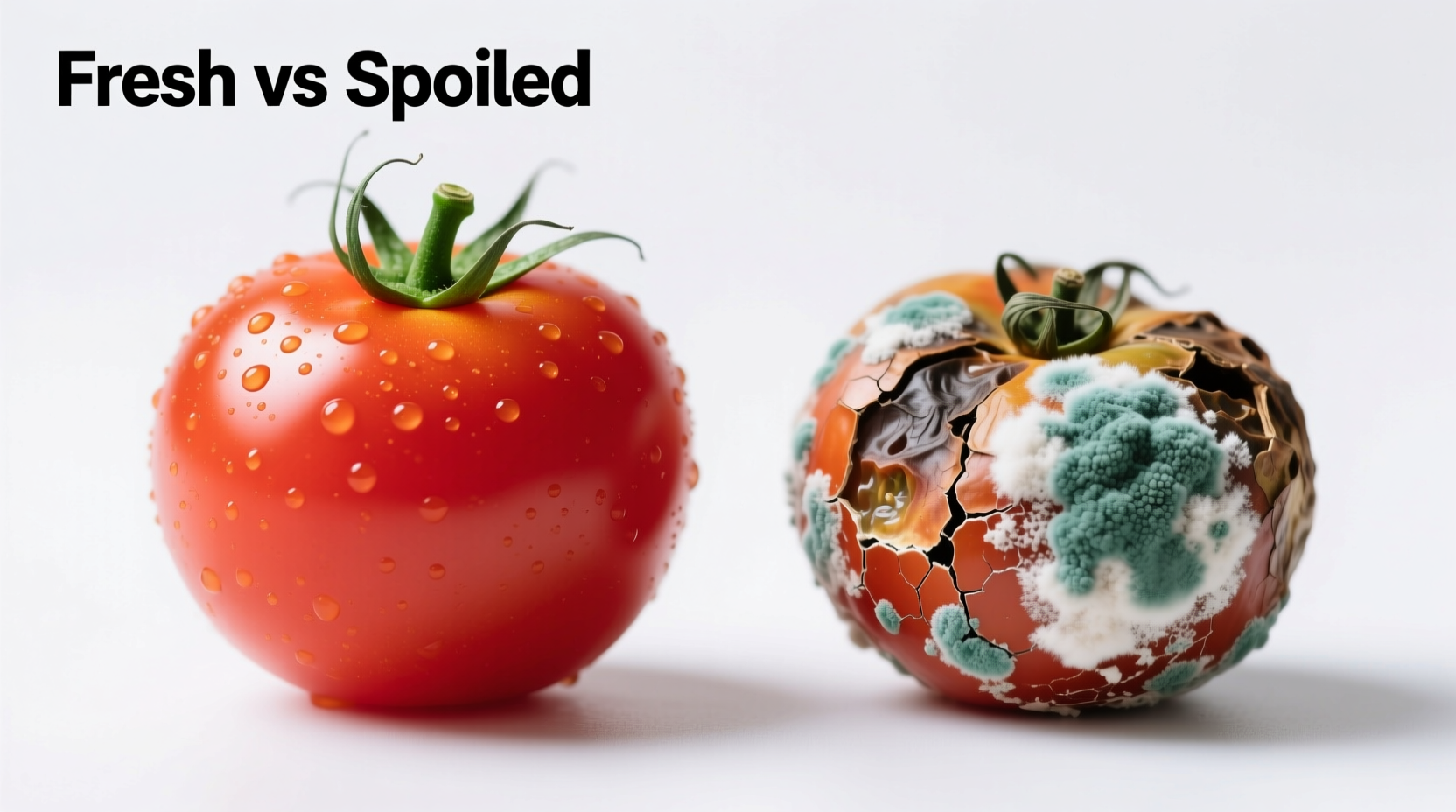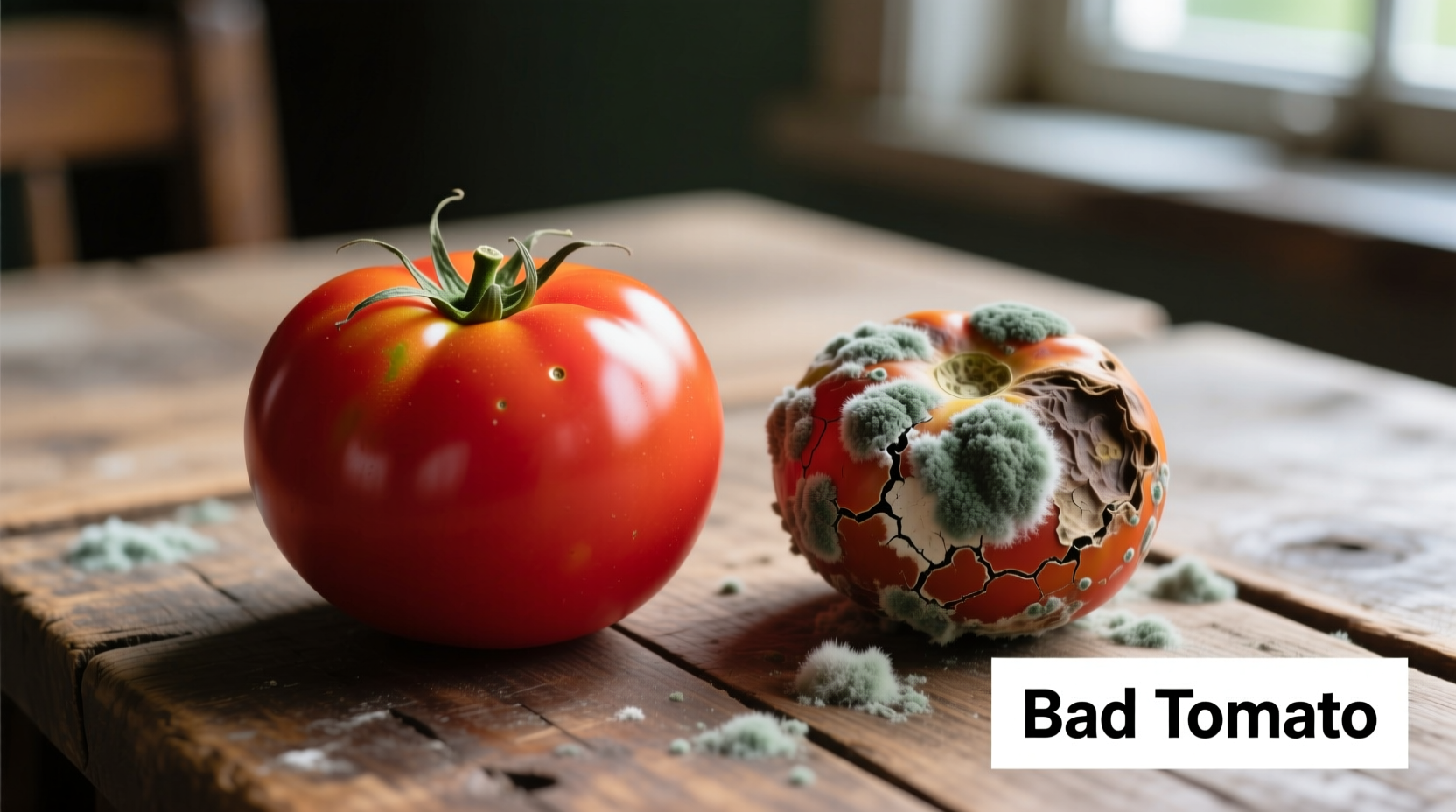Spot spoiled tomatoes instantly: check for soft spots larger than a dime, dark mold patches, leaking liquid, or a sour, fermented smell. Fresh tomatoes should feel firm with smooth skin, vibrant color, and a sweet earthy aroma. When in doubt, cut it open—brown or black interior means discard immediately.
Tomatoes rank as America's third most wasted produce item according to USDA data, with households discarding nearly 40% of purchased tomatoes due to improper spoilage identification. Knowing exactly how to tell if a tomato is bad saves money and prevents foodborne illness. This guide delivers science-backed indicators you can verify in under 10 seconds using sight, touch, and smell.
Visual Warning Signs of Spoilage
Your eyes provide the first line of defense against bad tomatoes. While minor surface blemishes are normal, these visual cues indicate definite spoilage:
| Good Tomato Indicators | Bad Tomato Indicators |
|---|---|
| Uniform vibrant color (red, yellow, or purple depending on variety) | Large dark spots (larger than a quarter) or blackened areas |
| Tight, unbroken skin without wrinkles | Visible mold patches (white, green, or black fuzzy growth) |
| Stem area intact and green | Wrinkled or shriveled skin, especially near stem |
| No liquid seepage | Clear liquid oozing from surface |
This tomato spoilage comparison chart reflects research from the University of California's Postharvest Technology Center, which confirms that mold growth and liquid leakage represent irreversible spoilage requiring immediate disposal (UC Davis, 2023).
Tactile Indicators: What Your Fingers Reveal
Gently squeeze tomatoes to assess firmness—a critical step whether shopping or checking stored produce. Proper technique matters:
- Fresh tomatoes yield slightly under gentle pressure but rebound immediately
- Early spoilage shows as localized soft spots that don't bounce back
- Advanced spoilage feels uniformly mushy or watery throughout
- Danger zone includes any tomato with slimy surface texture
Food safety experts at Cornell University note that texture changes often precede visible mold by 24-48 hours. Their research shows that once a tomato develops soft spots exceeding 10% of its surface area, internal decay has already begun (Cornell Food Safety Lab, 2024).

Smell Test: The Definitive Spoilage Check
Your nose detects spoilage before eyes in many cases. Proper smelling technique:
- Hold tomato 2-3 inches from nose
- Sniff gently (never directly on potentially moldy produce)
- Identify these critical scent warnings:
A fresh tomato smell should be mildly sweet with earthy notes. Discard immediately if you detect:
- Vinegar-like sourness (sign of fermentation)
- Musty basement odor (early mold growth)
- Completely odorless flesh (indicates advanced decay)
The USDA's FoodKeeper app confirms that sour or fermented odors indicate lactic acid bacteria growth, making tomatoes unsafe to eat regardless of appearance.
Internal Examination: When to Cut for Confirmation
Sometimes external signs aren't definitive. Perform this quick internal check:
- Cut tomato horizontally through the equator
- Examine cross-section for:
- Bright red, firm interior = safe to eat
- Brown or black discoloration = discard entire tomato
- Cloudy liquid around seeds = early spoilage (use immediately)
Michigan State University's food safety department emphasizes that internal browning indicates enzymatic breakdown that spreads rapidly, even if surface appears normal (MSU Food Safety, 2024).
Tomato Spoilage Timeline: What to Expect
Understanding decay progression helps determine if you can salvage partially spoiled tomatoes:
- Day 1-3: Peak freshness, firm texture, vibrant color
- Day 4-5: Slight softening at stem end, may develop minor surface blemishes
- Day 6-7: Noticeable soft spots, possible wrinkling, diminished aroma
- Day 8+: Mold development, liquid leakage, sour odor - discard immediately
This tomato freshness timeline varies by storage conditions. Refrigeration extends shelf life but affects flavor—room temperature storage maintains optimal taste for 5-7 days according to USDA recommendations.
Context Matters: When Indicators Differ
Not all soft spots mean spoilage. Consider these context factors:
- Varietal differences: Heirloom tomatoes naturally softer than commercial varieties
- Ripeness stage: Fully ripe tomatoes yield slightly to pressure
- Storage conditions: Refrigerated tomatoes develop texture changes faster
- Surface damage: Small cuts may cause localized softening without full spoilage
The FDA's Produce Safety Rule clarifies that minor surface imperfections don't compromise safety, but any sign of mold penetration requires complete disposal to prevent mycotoxin exposure.
Food Safety Protocol: When to Definitely Discard
Follow this decision tree for questionable tomatoes:
- Visible mold present? → Discard entire tomato (don't cut around it)
- Leaking liquid? → Discard immediately
- Sour smell? → Discard even if appearance seems okay
- Internal browning? → Discard entire tomato
- Only minor soft spots? → Cut away affected area plus 1-inch margin
Remember: how to identify rotten tomatoes properly prevents exposure to harmful bacteria like Salmonella that thrive in decaying produce. When uncertain, follow the USDA's "when in doubt, throw it out" principle for produce safety.
Maximizing Freshness: Storage Best Practices
Extend tomato shelf life with these evidence-based methods:
- Store at room temperature away from direct sunlight until fully ripe
- Place stem-side down to reduce moisture accumulation
- Never refrigerate unripe tomatoes (halts ripening process)
- Refrigerate only fully ripe tomatoes you won't use within 2 days
- Keep separate from ethylene-producing fruits like bananas
These tomato storage tips come from peer-reviewed research in the Journal of Food Science showing proper storage can extend freshness by 30-50% compared to common household practices.











 浙公网安备
33010002000092号
浙公网安备
33010002000092号 浙B2-20120091-4
浙B2-20120091-4